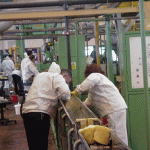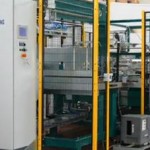What is Autonomous Maintenance
Autonomous maintenance is “independent” maintenance carried out by the operators of the machines rather than by dedicated maintenance technicians. This is core concept of TPM or Total productive maintenance, much like TQM (total quality management), TPM gives more responsibility and authority to the operators and releases the technical personnel to do more preventative and improvement works.
Unlike traditional maintenance programs where the operators run the machines until they break or become due for maintenance and then hand them to the maintenance department, autonomous maintenance has the operators performing the simpler (and safe) maintenance routines such as lubrication, bolt tightening, cleaning and also inspection and monitoring.
As the people that have day to day contact with the machines they are the most familiar with the operation of each machine and with full training can come to understand the functioning of the equipment. This enables them to feel greater ownership for their work and become more in control of how things are done and what improvements are made.
TPM Autonomous Maintenance
Total Productive maintenance was developed by Japanese companies in response to what was then total quality control (TQC), they found that certain aspects of TQC (or TQM as we now know it) did not fit very well into a maintenance program. They therefore adapted the TQM around the various maintenance programs that they had seen in American firms such as Preventive maintenance and predictive maintenance and developed what we now know as TPM.
TPM holds the involvement of everyone as one of its key principles and thus makes the operators who use the machines more responsible for the upkeep of the machines as well as the running of them.
Obviously to get to this point the operators require training and many machines need improvement and modification to make them easy to clean and maintain, we therefore need a methodical implementation program to introduce them to TPM and autonomous maintenance.
This program is most commonly broken down into seven steps;
Seven Steps of Autonomous Maintenance
Cleaning and Inspection
This is a similar stage to the 5S Shine stage with a similar purpose. We need to remove all dirt and grime from the machine, not for the purposes of making the machine pretty but to uncover and highlight any and all problems within the machine. This will require the machine to be taken out of production, all fluids drained and covers removed so that every part of the machine can be inspected and cleaned. We seek to remove the grime of past years and bring the machine back to how it was when it was first purchased, thoroughly inspecting each and every part of the machine to highlight any damage or wear.
We use Red Tags to highlight any problems, these problems if possible should be rectified immediately but if necessary a plan should be put in place to fix problems and remove the remaining red tags.
The cleaning and inspection should be done by the operators and maintenance crew responsible for the machine so that they become familiar with the machines details and can see where dirt accumulates and how and what problems are occurring.
Remove Causes of Contamination and improve Access
When we clean and inspect our machines we should look at where the dirt that we remove is coming from; is it being produced inside the machine or is it coming into the machine from outside. We should seek to either remove or minimise these sources of contamination that cause us to need to clean our machines.
We should also look at any areas that are difficult to reach or that may be unsafe to improve access to them so that future cleaning and inspection can be done without problems and as quickly as possible. This can also include the replacement of covers with Perspex or similar see through materials so that checking is much easier.
Cleaning and Lubrication Standards
The first two stages set the stage for the operators to define the maintenance steps that they can conduct to prevent further deterioration of the machine. They have to define what they will clean, lubricate, tighten and inspect, how they will do it, how often and so forth to ensure that they keep the machine in its optimum condition.
Train for general Inspections
We now have the experts (maintenance technicians, team leaders) conduct in depth training with the operators to explain the function and purpose of each component of the machine as well as training in problem solving skills such as the 5 whys.
We then have the operators re-inspect the machines with their new-found knowledge and highlight any new problems discovered in much the same way that we did in stage one.
Conduct Autonomous Inspections
With what they have learned in stage 4 the operators modify the standards and instructions that they put in place for the first three stages of autonomous maintenance to streamline and improve their maintenance tasks.
The tasks at this stage are also compared and rationalized with the maintenance departments own maintenance schedules allowing tasks to be allocated correctly and prevent duplication of effort.
Implement Visual Maintenance Management
Just as in 5S, one of the main aims of TPM is standardisation, we seek to standardise the maintenance work that we do and also try to make the workplace as “visual” as possible. We create formal standards for our autonomous maintenance and look at improving the visual management of our machines. We highlight the direction of flow of fluids through pipework, which way levers and valves have to be turned to open and close, highlight “safe” or “normal” operating values on gauges and sight glasses in green and undesirable readings in red, all to make things as obvious as possible to anyone if things are operating correctly. The various principles of 5S should be thoroughly applied not just to the machine but the relevant associated equipment, tools and materials.
A useful tool to use to visually monitor the maintenance process and 5S tasks is that of the Kamishabi board, this is a simple T card planning board that is placed in the work cell showing the various tasks that need to be completed each and every day and when. These cards should carry the instructions as to what needs to be done and when completed they should be turned on the board to reveal a different colour to show that they have been completed. The kamishabi board therefore provides a very quick and easy check for everyone in the organisation to see if tasks have been completed when they should have been.
Continuous Improvement
We repeat and improve on all that we have found and done in the previous stages to continually improve and reinforce what we are doing with autonomous maintenance. We maintain good records of what we have done and the failures that occur and so forth that can then be fed back to the maintenance technicians to be integrated into future designs of machines to improve reliability and make maintenance easier.
Team leaders, managers and maintenance technicians should also audit the work done by the operators on a regular basis to be able to both congratulate the operators on a job well done and to give them the benefits of their knowledge.
Autonomous Maintenance Video
Implementing TPM and Autonomous Maintenance.
Like all other Lean Manufacturing tools; Total productive maintenance and Autonomous Maintenance have to be adapted to your specific company and culture to work successfully, if you have any comments or questions please leave them below.



I am TPM Specialist at YKK which is a Japan based international company. I am working at YKK Turkey. It is one of the overseas company of the YKK Corporation.
should i need to implement a check list to control operator Autonomous maintenance actions?
Hi Efren,
It is always best to provide some form of checklist so that the operators have both a reminder and a record of what needs to be done. For more complex maintenance there should also be clear instructions as to the best ways to undertake the operation.
Thanks for your feedback. 🙂
Absolutely, they should have a checklist, and include photos on it. I love visual controls – so I am a proponent of posting these types of documents in the area where they will be used. They can be framed and under glass or laminated, whichever is most suitable. A training on using the checklist and performing these tasks is a must also. When using a checklist or having someone take log readings, some sort of identifier is a helpful tool. For example, is there is a log reading for a pressure gage, the log would be numbered and in this case would be #1. The pressure gage in the field would also have a “#1” affixed to it and somehow highlighted in green for normal operating range and red for high and low limits. The checklist or log should also indicate the normal range corresponding to the gage markings. This seems like a huge task, but it can be accomplished during the first few operator rounds.
Thanks for your feedback!
do these extra duties that the operators have to perform include money. the management team is so excited. continuous improvement means annual reviews where you are shown where you need to improve with no mention of money. workforce kept at stagnant wages where somebody with ten years seniority makes the same as somebody there two years or twenty. cost of living is considered a raise. YAY the management team is so excited
Hi Mike,
Not all companies use Lean and autonomous maintenance and other ideas as ways to get more from the employees without any benefit to them. Often it the employees themselves that feel the benefits of what they are doing in machinery and processes that actually perform reliably.
Wages and lack of pay rises are another issue entirely and not something that can be blamed on lean. Lean is about involving the operators to make their lives easier and give them more control over their workplace.